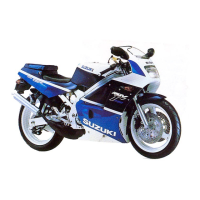GENERAL INFORMATION
DFUEL
The engine is of two-stroke type, designed to run on oil~premixed fuel (when the oil pump is removed).
Fuel specification: Racing gasoline or aviation gasoline mixed with oil in the ratio of 30 : 1.
Oil specification : Motul 700E, Shell Sports SX (synthetic).
2) COOLANT
Coolant specification: Soft drinkable water
When filling the cooling system with water, follow the procedures below.
(1)
Remove the radiator cap and pour water through the filler neck.
(2) Bleed air from the water pump.
(3) Holding the handlebars, lean the motorcycle two or three times to expel air trapped in the system.
(4) Squeeze each radiator hose to drive air away.
(5) Loosen the air bleed bolt on the side of radiator to remove air.
(6) Repeat the procedures (1) through (5) above until the water lever becomes constant.
(7) Fit the radiator cap securely.
After the above procedures are completed, start and warm up the engine, then check that there is no
water is no water leakage. Stop the engine, allow to cool and check the water level again.
• During the race interval, drain the system completely to avoid corrosion or other harmful problems in
the radiator and engine water jacket.
• The water temperature for best engine operation is 55
—
65°C.
When more than 70°C, considerable power loss will result.
3) WARMING UP
Always warm up the engine before running in the following manner:
(1)
For
1 —
2 minutes, rev the engine up and down within the range of 5,000
—
6,000 rpm.
(2) For another 1
—
2 minutes, rev the engine up and down limiting the highest revolution to 8,000 rpm.
(3) When the water temperature reaches approximately 65°C, test drive for approximately 50 m and
check the operation of gearshifting, clutch, brake etc if an appropriate warming up site is available.
(If the water temperature rises to more than 90°C, check the system immediately because there may
be problems like leakage, insufficient water etc.)
4) BREAK IN
(1) New machine
Keep the engine speed as constant as possible during running. To shift up or down, keep to the following
rpm limits. Use as high gear as is practically possible.
a. First, run 2
—
3 times in the track limiting the engine speed below 8,000 rpm.
b. Stop and check for parts looseness, leakage etc.
c. Run approximately 30 km limiting the engine speed below 8,000 rpm.
d.
Run approximately 20 km limiting the engine speed below 9,000 rpm.
e. Run approximately 20 km limiting the engine speed below 10,000 rpm.
The total of running distance is approximately 75 km.
CAUTION:
During breaking in period, run the engine on slightly rich carburetion.
(2) When parts replaced
• If the cylinder or crankshaft is replaced, the same break in as new machine is required (approximately
75 km).
_2-

